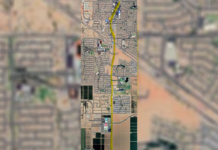
Voters in Maricopa faced a big decision Nov. 2 in deciding the fate of Proposition 457, the continuation of the Maricopa Unified School District’s 10% budget override. And while the election wasn’t going to determine city policy, city officials believe it will help shape the future of its schools — and the city at large.
City taxpayers had to decide whether to continue funding a 10% budget override for schools. Supporters stressed the override was not a new tax, and that a “Yes” vote was simply an extension of a critical funding mechanism in place since 2016.
The override passed, although by a razor-thin margin of just over 1% with 4,200 votes, or 50.46% of the vote, for continuation, and 4,124 votes, or 49.54%, against.
MUSD Governing Board president Ben Owens said the override reaches every part of the district.
“The renewal of the override is a significant win for the students in MUSD,” Owens said. “The funding provided by the override impacts every child in our district. Thank you to voters for the continued support. We appreciate the hard work of so many that worked to help share the MUSD story and why the override is so important.”
The override was originally approved five years ago by voters. It allows the district to exceed its management and operations (M&O) budget by 10%, about $5 million per year in MUSD’s case. That is a big number with an enormous impact on education in the city.
“That $5 million equates to about 70 teachers and counselors,” district Superintendent Tracey Lopeman explained before the election. “Most of the funding goes to teacher and staff salaries. Also, $500,000 goes to the Ram Academy and $500,000 to technology, for which the last override helped meet the district’s 1:1 goal of a laptop for every student and teacher.”
According to Christine Dickinson, a member of the Yes for MUSD Schools Political Action Committee, the override allowed the district to be prepared for the remote learning necessitated by the COVID pandemic.
“We have a computer for every child,” she has said previously. “The district now has an inventory of over 8,000 computers, and every teacher has their own laptop. Our new, updated technology thanks to the override is much more efficient and more mobile, so that during the pandemic they could take the computer home with them. It (the override) is a necessity.”
In the runup to the vote, Lopeman pointed out that had the district not had that 1:1 ratio of technology — every student having a laptop — “we would have been in really rough shape with the COVID outbreak. We would not have been able to conduct remote learning like we did with all our students.”
Funding has been an issue for schools in Maricopa — and across Arizona — for years. The state government has traditionally funded schools at a low level, which led to the “Red for Ed” movement in 2018, which culminated in a successful state ballot initiative that resulted in a tax on the wealthiest Arizonans to fund education at a higher level.
According to city councilmember Bob Marsh, who supported the continuation, education funding challenges are nothing new.
The override “helps make up for reductions in school funding coming from the state, where the legislature has a history of meager education funding,” he has said, explaining the need for the override.
“For more than 30 years, Arizona has experienced a decline in public education budgets, leaving us near the bottom of the country. Our school districts do their best to do more with less, but this override is critical for investing in new technology, for the important RAM Academy…program, and for maintaining approved class sizes.”
As Maricopa’s population has soared over the past 15 years, so have the number of students in MUSD. Supporters say the override is crucial to keeping pace with that growth.
Enrollment in MUSD’s nine schools grew 21% from 2015-16 until last school year and is expected to reach nearly 10,000 students by 2025-26, an increase of more than 50% in just 10 years.
The cost of the override is low. Residents pay about 38 cents per day to cover its cost (per $100,000 of assessed value on their home), or about $11.40 per month.
City Manager Rick Horst said the benefits of the override far outweigh the cost.
“The greatest economic tool we have is our citizens, and that includes our youth,” Horst said. “They will one day be our business owners and the leadership of this community. They will be the schoolteachers, the firefighters, all those types of things. I think it’s very short-sighted to say, ‘Well, my kids don’t live here, I don’t want to pay that tax.’
“You can take that approach, but eventually you’re going to have to pay more. You’ll have to pay for more police officers, because of increased crime, pay to clean up vandalism, blight, all those other things, because education is the heart and soul of our community, and it always has been. And frankly, it’s the heart and soul of our nation.”
Governing Board member Robert Downey also commented on the override’s impact on the bigger picture for the city.
“All parents want their kids to do well in life, to do better than they did,” Downey said.
“They want their kids to be taught that each one of them can reach the sky and go beyond.
A proper education is a critical component in making that dream a reality. By supporting the override, parents and the community are sending a message that they support MUSD and its goal to provide additional support for those kids who need it.
Lopeman said the override’s greatest benefit is lower class sizes, even accounting for explosive growth in student population. The 2016 override, which enable the hiring of dozens more teachers and staff, reduced the district’s average class size by 6-8 students, depending upon the grade. She said those numbers make a huge difference.
“When you have class sizes that are low, that’s one way to attract and maintain quality teachers,” she said. “When we attract and maintain quality staff, the quality of our product continues to elevate. One of the biggest benefits to this is having class sizes that are enviable.”
Had the override vote failed, MUSD’s future was gloomy. While Lopeman had stressed the quality of education would have remained high due to the district’s quality teachers, the educational experience for children, and the work environment for the teachers and staff, would have diminished.
The district would have seen reductions of 6-8 teachers in each of the district’s six elementary schools, 7-11 fewer in each middle school and another 11 at Maricopa High School. Other cuts could have included a RAM counselor, a RAM teacher on special assignment, three elementary school counselors, two instructional tech specialists and one elementary school librarian.
Lopeman said that in addition to addressing the shortcomings in the state’s funding of schools, the override can have broader implications in the community.
“The State of Arizona does not fund low class size,” Lopeman said. “It does not fund technology the way that it should. So, when we have this additional funding that the voters approved, it creates class sizes and systems that are attractive to teachers. When we can tell a teacher their community supports them, that’s attractive.
“What if we can get teachers to invest in, and move to, and stay in Maricopa,” she continued. “That elevates our whole community.”
Passage of the override also keeps MUSD competitive with school districts in the surrounding areas, most of which also have overrides in place. The Kyrene, Tempe Elementary, Tempe Union, and Chandler Unified districts all have 15% overrides; the Casa Grande Elementary and Casa Grande Union High School districts are at 10%.
Lopeman said the vote showed that the city appreciates what MUSD is doing.
“We are grateful for the support and confidence of our community,” she said. “This is an endorsement of the work our teachers and staff do every day.”



![Carl’s Jr plans to “open soon” An exterior view of the new Carl's Jr. restaurant along John Wayne Parkway on May 7, 2024. [Elias Weiss]](https://www.inmaricopa.com/wp-content/uploads/2024/05/E1C66482-CB4C-4FD0-BA30-35CECE93F4BE-218x150.jpeg)

![Filiberto’s eyes building Maricopa restaurant An exterior view of a Filiberto's Mexican Food restaurant at an unknown location and date. [Jessica Boehm/Axios]](https://www.inmaricopa.com/wp-content/uploads/2024/05/axios-050724-filibertos-screenshot-e1715117410101-218x150.jpg)



![SR 238 closures start tomorrow SR 238 [File]](https://www.inmaricopa.com/wp-content/uploads/2022/04/az-238_e_seq_034-218x150.jpg)






![Carl’s Jr plans to “open soon” An exterior view of the new Carl's Jr. restaurant along John Wayne Parkway on May 7, 2024. [Elias Weiss]](https://www.inmaricopa.com/wp-content/uploads/2024/05/E1C66482-CB4C-4FD0-BA30-35CECE93F4BE-100x70.jpeg)
